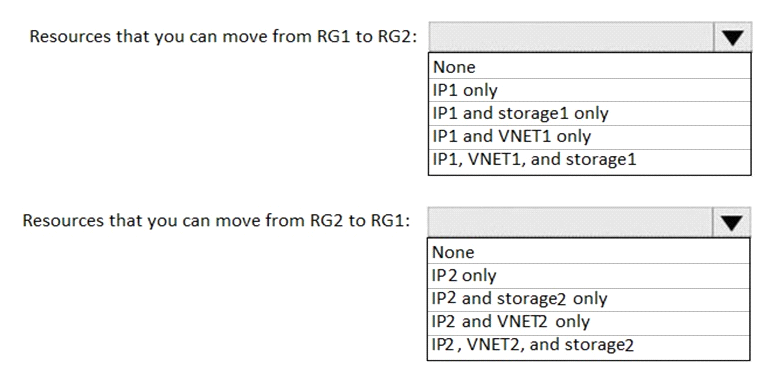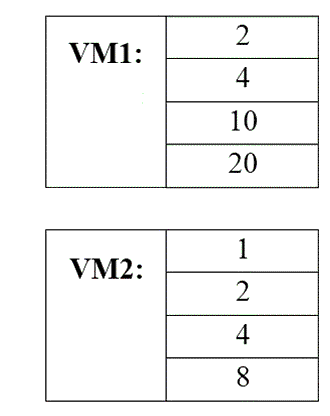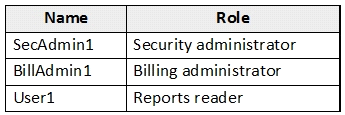Free Microsoft AZ-104 Exam Dumps
Here you can find all the free questions related with Microsoft Azure Administrator Exam (AZ-104) exam. You can also find on this page links to recently updated premium files with which you can practice for actual Microsoft Azure Administrator Exam . These premium versions are provided as AZ-104 exam practice tests, both as desktop software and browser based application, you can use whatever suits your style. Feel free to try the Microsoft Azure Administrator Exam premium files for free, Good luck with your Microsoft Azure Administrator Exam .MultipleChoice
You have an azure subscription that contain a virtual named VNet1. VNet1. contains four subnets named Gatesway, perimeter, NVA, and production.
The NVA contain two network virtual appliance (NVAs) that will network traffic inspection between the perimeter subnet and the production subnet.
You need to implement an Azure load balancer for the NVAs. The solution must meet the following requirements:
* The NVAs must run in an active-active configuration that uses automatic failover.
* The NVA must load balance traffic to two services on the Production subnet. The services have different IP addresses
Which three actions should you perform? Each correct answer presents parts of the solution.
NOTE: Each correct selection is worth one point.
OptionsHotspot
You have an Azure subscription that contains the resource groups shown in the following table.

RG1 contains the resources shown in the following table.

RG2 contains the resources shown in the following table.

You need to identify which resources you can move from RG1 to RG2, and which resources you can move from RG2 to RG1.
Which resources should you identify? To answer, select the appropriate options in the answer area.

Read only and Delete lock won't prevent you from moving resources in different resource groups. It will prevent you to do the operations in the resource group where the resources are there.
So the correct answer should be
RG1 --> RG2 = IP1, vnet1 and storage1
RG2 --> RG1 = IP2, vnet2 and storage2
DragDrop
You have an Azure Linux virtual machine that is protected by Azure Backup.
One week ago, two files were deleted from the virtual machine.
You need to restore the deleted files to an on-premises computer as quickly as possible.
Which four actions should you perform in sequence? To answer, move the appropriate actions from the list of actions to the answer area and arrange them in the correct order.





























MultipleChoice
You create an App Service plan named App1 and an Azure web app named webapp1. You discover that the option to create a staging slot is unavailable. You need to create a staging slot for App1.
What should you do first?
OptionsHotspot
You have an Azure Migrate project that has the following assessment properties:
* Target location: East US
* Storage redundancy: Locally redundant
* Comfort factor: 2.0
* Performance history: 1 month
* Percentile utilization: 95th
* Pricing tier: Standard
* Offer: Pay as you go
You discover the following two virtual machines:
* A virtual machine named VM1 that runs Windows Server 2016 and has 10 CPU cores at 20 percent utilization
* A virtual machine named VM2 that runs Windows Server 2012 and has four CPU cores at 50 percent utilization
How many CPU cores will Azure Migrate recommend for each virtual machine? To answer, select the appropriate options in the answer area.
NOTE: Each correct selection is worth one point.

Hotspot
You have an Azure subscription that contains an Azure Directory (Azure AD) tenant named contoso.com. The tenant is synced to the on-premises Active Directory domain. The domain contains the users shown in the following table.

You enable self-service password reset (SSPR) for all users and configure SSPR to have the following authentication methods:
* Number of methods required to reset: 2
* Methods available to users: Mobile phone, Security questions
* Number of questions required to register: 3
* Number of questions required to reset: 3
You select the following security questions:
* What is your favorite food?
* In what city was your first job?
* What was the name of your first pet?
For each of the following statements, select Yes if the statement is true. Otherwise, select No.
NOTE: Each correct selection is worth one point.

MultipleChoice
You have an Azure subscription that contains the following resources:
* 100 Azure virtual machines
* 20 Azure SQL databases
* 50 Azure file shares
You need to create a daily backup of all the resources by using Azure Backup.
What is the minimum number of backup policies that you must create?
OptionsMultipleChoice
You have an Azure virtual machine named VM1.
You use Azure Backup to create a backup of VM1 named Backup1.
After creating Backup1, you perform the following changes to VM1:
* Modify the size of VM1.
* Copy a file named Budget.xls to a folder named Data.
* Reset the password for the built-in administrator account.
* Add a data disk to VM1.
An administrator uses the Replace existing option to restore VM1 from Backup1.
You need to ensure that all the changes to VM1 are restored.
Which change should you perform again?
OptionsMultipleChoice
Note: This question is part of a series of questions that present the same scenario. Each question in the series contains a unique solution that might meet the stated goals. Some question sets might have more than one correct solution, while others might not have a correct solution.
After you answer a question in this section, you will NOT be able to return to it. As a result, these questions will not appear in the review screen.
You have an Azure subscription that contains the following resources:
* A virtual network that has a subnet named Subnet1
* Two network security groups (NSGs) named NSG-VM1 and NSG-Subnet1
* A virtual machine named VM1 that has the required Windows Server configurations to allow Remote Desktop connections
NSG-Subnet1 has the default inbound security rules only.
NSG-VM1 has the default inbound security rules and the following custom inbound security rule:
* Priority: 100
* Source: Any
* Source port range: *
* Destination: *
* Destination port range: 3389
* Protocol: UDP
* Action: Allow
VM1 connects to Subnet1. NSG1-VM1 is associated to the network interface of VM1. NSG-Subnet1 is associated to Subnet1.
You need to be able to establish Remote Desktop connections from the internet to VM1.
Solution: You modify the custom rule for NSG-VM1 to use the internet as a source and TCP as a protocol.
Does this meet the goal?
OptionsMultipleChoice
Note: This question is part of a series of questions that present the same scenario. Each question in the series contains a unique solution that might meet the stated goals. Some question sets might have more than one correct solution, while others might not have a correct solution.
After you answer a question in this section, you will NOT be able to return to it. As a result, these questions will not appear in the review screen.
You have an Azure subscription that contains the following resources:
* A virtual network that has a subnet named Subnet1
* Two network security groups (NSGs) named NSG-VM1 and NSG-Subnet1
* A virtual machine named VM1 that has the required Windows Server configurations to allow Remote Desktop connections
NSG-Subnet1 has the default inbound security rules only.
NSG-VM1 has the default inbound security rules and the following custom inbound security rule:
* Priority: 100
* Source: Any
* Source port range: *
* Destination: *
* Destination port range: 3389
* Protocol: UDP
* Action: Allow
VM1 connects to Subnet1. NSG1-VM1 is associated to the network interface of VM1. NSG-Subnet1 is associated to Subnet1.
You need to be able to establish Remote Desktop connections from the internet to VM1.
Solution: You add an inbound security rule to NSG-Subnet1 that allows connections from the Any source to the VirtualNetwork destination for port range 3389 and uses the TCP protocol. You remove NSG-VM1 from the network interface of VM1.
Does this meet the goal?
Options
